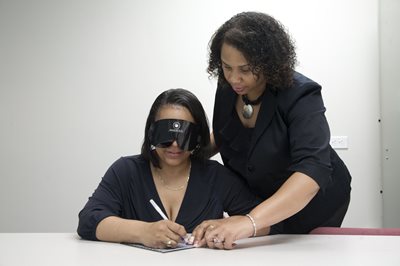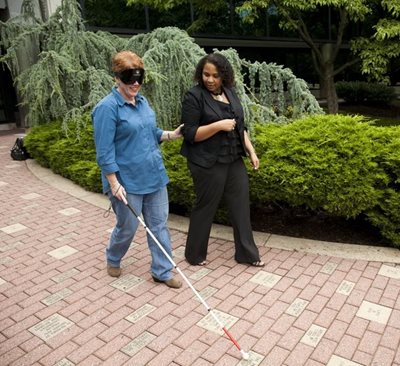Lachelle Smith, MS, CVRT, views Vision Rehabilitation Therapists (VRT) — a discipline that prepares professionals to work with individuals who are blind or visually impaired perform daily living skills safely and independently — as the “general practitioners” of blindness and visual impairment services.
 “The profession has a rich and beautiful history, starting with people who were blind teaching others who were blind to be self-sufficient through discovering adaptive strategies and techniques to take care of themselves, their families and homes,” said Smith, assistant professor and director of the Vision Rehabilitation Therapy at Salus University.
“The profession has a rich and beautiful history, starting with people who were blind teaching others who were blind to be self-sufficient through discovering adaptive strategies and techniques to take care of themselves, their families and homes,” said Smith, assistant professor and director of the Vision Rehabilitation Therapy at Salus University.
The profession that attracts a diverse group of individuals from a variety of educational and professional backgrounds, including but not limited to, special education, disability services, rehabilitation studies, social work, psychology, occupational therapy, financial services careers, healthcare professions (including doctors and nurses), and so many more, added Smith.
 VRT training programs are offered at the graduate level (except for one newly established undergraduate program) and involve intense training in all related areas of visual functioning, assessment and intervention, and low vision and non-visual skills training in specialized adaptive techniques and strategies under blindfold and low vision simulation. The Salus VRT program attracts masters and certificate students from the U.S. as well as other countries.
VRT training programs are offered at the graduate level (except for one newly established undergraduate program) and involve intense training in all related areas of visual functioning, assessment and intervention, and low vision and non-visual skills training in specialized adaptive techniques and strategies under blindfold and low vision simulation. The Salus VRT program attracts masters and certificate students from the U.S. as well as other countries.
This week, April 12 through April 16, is Vision Rehabilitation Therapist Appreciation Week. Observed every year the week of April 14, it commemorates the birth date of Anne Sullivan on April 14, 1866. Sullivan is one of the early pioneers of vision rehabilitation and is noted for her work with Helen Keller (1880-1968), American author, disability rights activist, and lecturer.
 VRT areas of specialty include:
VRT areas of specialty include:
VRT has evolved significantly over the past 200 years of its existence. Through three professional title changes —home teacher, rehabilitation teacher and Vision Rehabilitation Therapist — and multiple layers of national certification, to its current status of one of five primary blindness and low vision professions, the VRTs’ impact on the education and rehabilitation of individuals with visual impairments has remained unchanged.